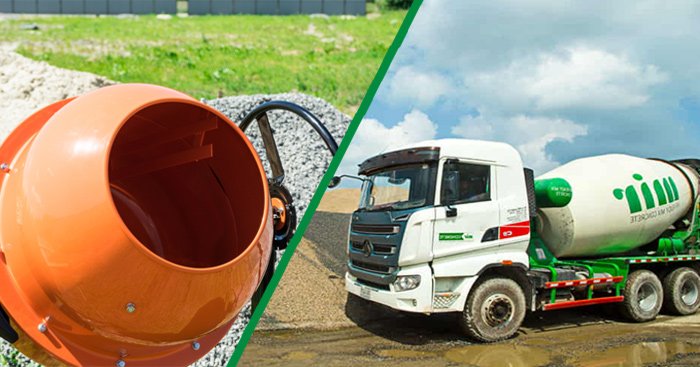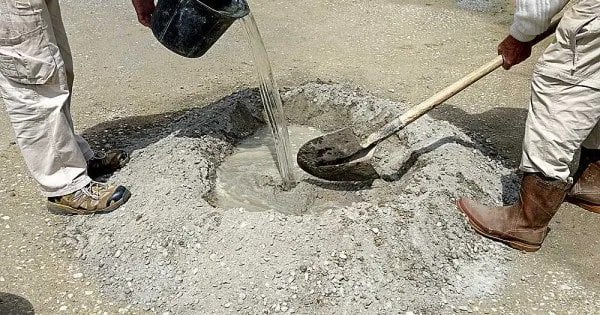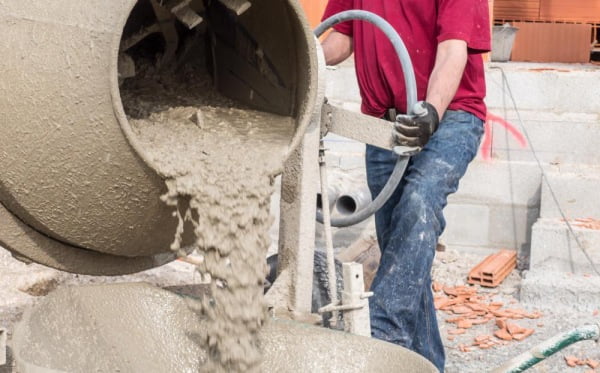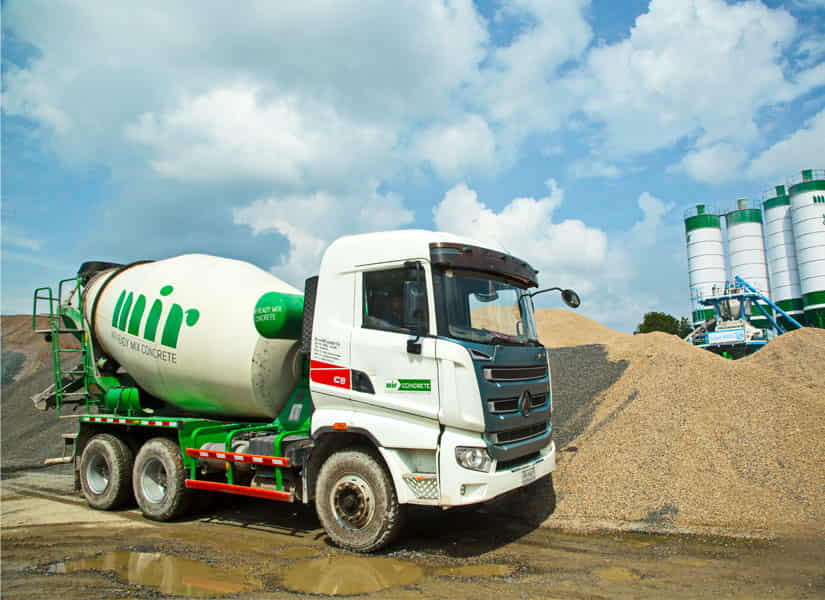Differences Between Ready Mix Concrete and Site Mix Concrete
Differences Between Ready Mix Concrete and Site Mix Concrete
- February 5, 2022
- Posted by: Mir Ready-mix Concrete
- Category: General Construction, Green Building, House Renovation, Tips

Among all the materials used in construction, concrete is undoubtedly the most valuable and inalienable part of the construction industry. For centuries concrete has been the first choice for its strength, adaptability, durability, and reflectivity. Concrete being the most essential building material, as we all know, the quality of concrete plays a significant role in construction.
“The Imperial vastness of late Roman architecture was made possible by the invention of concrete.“
Nonetheless, the quality of concrete varies depending on the style of its preparation. Ready-mix concrete and site mix concrete are two different approaches of concrete preparation widely used in the construction industry. Both variations of concrete have their advantages and disadvantages. The following article may help any potential building developer draw a line between Ready Mix Concrete and Site Mix Concrete.
Checklist
The necessity of quality concrete mix
Concrete is a structural material produced by mixing coarse and fine aggregates (sand) with water and cement, which hardens over time. In modern construction, calcium chloride is used in concrete to enhance its qualities, such as setting time and strength. Fine aggregates or sand are river-deposited particles with less than 4.75 mm and larger than 0.2 mm. Coarse aggregates usually consist of crushed stones, stone boulders, and gravel. Fine and coarse aggregates are inert materials, whereas water and cement are active materials. In most cases, cement is the primary binding agent in concrete.
Until recently, the procedure of mixing concrete followed a conventional approach. Upon collecting the raw components, a predetermined ratio needs to be maintained to prepare concrete with suitable strength. A high-quality concrete mix can provide a solid foundation for a solid infrastructure. It usually requires considerable planning in which a mixture of ingredients is used to allow the concrete structure to achieve the desired strength and longevity. It might be challenging to design a decent quality concrete mix since each element in the concrete mix has distinct characteristics. To determine the actual physical characteristics of the elements, all the components must be evaluated first. As a result, choosing the appropriate concrete mix is a vital step that must be taken into account for both location requirements and total cost. A high-quality concrete mix will give you a solid product with a favorable outcome. Hence, developers must know the differences between the two most widely used approaches of concrete mixing.

What Is Site Mix Concrete?
As the name implies, site mix concrete refers to concrete batched and mixed on the site. The components will be involved and mixed in specific ratios to achieve the desired strength. This particular method needs to use formulas to identify steps and amounts of materials to achieve the desired strength. To avoid quality problems in the concrete, concrete workers must be meticulous with the standard quantities of the ingredients. A task scheduling program might help you be more accurate with the conventional proportions. While the work is being done, the tool allows concrete professionals to control and supervise all deployed approaches and strategies.
There are a few factors to consider while using site mixed concrete:
- Time: Because of the multiple processes, setting time, and formulas involved, the procedure appears to be slower.
- Distribution: Concrete is mixed at the scheduled time of usage to avoid contamination and quality degradation.
- Equipment: A weigh batch mixer is required to manufacture concrete onsite.
- Storage Requirements: A secure storage facility is required to protect and manage commodities like aggregates and cement
- Waste: Material loss is common during mixing and storage.
- Quality: The purpose of continuous supervision is to ensure batch consistency.
- Material takeoff: Materials are estimated independently, and purchases are made case by case.
- Workforce: Concrete preparation on the job site takes several hours.
- Space: Batch mixers and material storage take a lot of room.
- Batch Size: It is challenging to mix large amounts of concrete on a construction site.
Also, there are various processes regarding the preparation of site mixed concrete.
- Hand-mixed Concrete
Hand mixing is only used in certain circumstances when quality control is not critical and the amount of concrete needed is small.

- Machine Mixed Concrete
Mechanical mixers are often utilized for bulk concrete when high quality is needed. There are different types of machines used for this purpose. They are called tilting mixers and non-tilting mixers.

Advantages of Site Mixed Concrete
- A well-organized and supervised process, apart from high quality and economical concrete.
- A modest quantity of batch can be required and produced in scheduled concrete works without depending upon any other external agencies.
- The design can be optimized based on the strength result, and project managers can save money using value engineering.
- There are greater flexibilities on the number of orders that can be placed.
- It is not required to rely on other entities to complete concrete projects.
- Site-mix concrete is around 20% less expensive than ready-mix concrete.
Disadvantages Of Site Mixed Concrete
- Stocking materials necessitate more space.
- It is crucial to take care of site logistics.
- Waste of old materials, as well as periodic reconciliation, must be closely checked.
- Onsite supervision of concrete manufacturing should be provided by qualified personnel.
What Is Ready Mix Concrete?
Ready-mix concrete, abbreviated as RMC, is made at a batching plant or a factory, where the ingredients of concrete are batched and mixed according to the proportions specified. Then, using transit mixers mounted on trucks, this ready-mix concrete is transported to the job site.
The first ready-mix concrete was created in 1930, although it was not widely used until the 1960s. Nowadays Ready-mix concrete is a popular choice in Bangladesh because of its advantages. The concrete arrives at the job site in the form of newly mixed concrete that is still plastic (i.e., unhardened state). After the concrete is brought to the job site, no more treatment is necessary; it can be placed straight in the formwork. Ready-mix concrete is bought and sold by volume and measured in cubic meters.

RMC’s Advantages
- A centralized plant is established for concrete batching, from which concrete may be readily delivered to multiple locations.
- Concrete quality is generated when the ingredients are batched and mixed with accuracy.
- Furthermore, the consistency of concrete quality may be accurately maintained.
- Construction speed is raised, and maintenance costs are lowered as concrete quality improves.
- It is capable of resolving the issue of concrete mixing in narrow roads. The factory can be located in remote industrial locations, and ready-to-use concrete is supplied to the job site.
- The space taken up by the materials held on the premises is freed up.
- In the case of RMC, there is no need to hire or purchase concrete preparation machines.
- Because concrete mixers are typically noisy, noise and dust pollution at the job site is decreased.
- The labor used in the concrete manufacturing process is also eliminated.
- There is less waste of primary materials in the facility compared to the site.
- When using ready-made concrete, modern construction techniques can be efficiently utilized.
- RMC is very effective for mass concreting and construction work in narrow locations.
RMC’s Disadvantages
- First and foremost, make sure that the site’s main road and access routes are not blocked.
- In the case of RMC, travel time from the facility to the site is critical. Materials are batch-processed at the central plant. On the other hand, the mixing occurs while the truck is in transit. The concrete will not be adequately mixed when it arrives onsite if the time is not carefully calculated and handled.
- Compared to onsite concrete, more careful preparation is required because the ready-mixed concrete arrives at the job site, and delays in placement can cause the concrete to solidify before it is placed.
- A concrete setting may occur if there is traffic on the route. During the transit of ready mix concrete, the unexpected nature of traffic may prove to be a concern.
What’s The Difference between Ready Mix Concrete Vs Site Mix Concrete?
Site-mixed concrete and ready-mix concrete are the two most common types of concrete used in buildings. These two forms of concrete differ somewhat in appearance. It’s vital to be aware of the distinctions, even if they appear little because knowing what they are will help you select the best concrete for your job. The following are the primary distinctions between site-mixed and ready-mix concrete:
Preparation
The manner these two types of concrete are mixed is one of the most evident variances. Ready-mix concrete is often made at a plant and given to customers in a ready-to-use condition. It’s usually sold by the cubic meter, which is how it’s measured.
On the other hand, site-mixed concrete is made at the client’s construction site. The components are blended in particular ratios to achieve varying degrees of strength. To avoid quality difficulties, care must be given when manufacturing this concrete.
Time
Construction projects are always time-sensitive, and speed is crucial. In this scenario, ready-mix concrete is preferable because it is easier to load and unload, potentially saving you time.
Because you have to pause part of the project while the mix is being made, volumetric concrete takes longer to work with.
Equipment
The equipment of construction is expensive. Often, to reduce the cost, the constructor rents the equipment. However, renting is also costly in the construction industry. While working on large construction projects, a considerable volume of concrete is required, and this demands the use of necessary concrete to prepare types of equipment for an extended period. It significantly adds to the overall expense of the project. However, if the constructor decides to use ready mix concrete, it will not require most types of equipment, and the general equipment cost will significantly decrease.
Convenience
Ready Mix Concrete is the most convenient type of concrete available. It is widely used in construction projects for its suitable qualities. Ready-made concrete can be prepared for use at one specific location, and then it can be delivered to multiple construction sites within the project site. On the contrary, site mix concrete needs to be prepared as close to the point of use as possible to avoid contamination and degradation of quality.
Quality
Compared to site-mixed concrete, ready-mix concrete offers higher and more uniform quality. This is because ready-mix concrete is mixed in a controlled and mechanized setting.
Amount of materials
The materials needed to manufacture site-mixed concrete must be assessed and acquired individually. On the other hand, ready-mix concrete is simply calculated as a single item.
Waste
Material loss occurs when working with site-mixed concrete, not only during mixing but also during storage. On the other hand, ready-mix concrete produces very little waste on your job site because it is delivered in a ready-to-use form.
Workforce
When working with ready-mix concrete, you may only require skilled labor when pouring and compacting the concrete. However, you will need more manpower when working with site mixed concrete.
Summary
There are significant differences between the Ready-Mix Concrete and Site Mix Concrete. It’s critical to do proper homework and figure out which sort of concrete is appropriate for a specific construction project. Ready-mix concrete is a superior alternative in general because it can be utilized for a more extensive range of applications. To summarize, despite rising costs, ready-mix concrete is usually better for most building projects. It provides significantly better quality, including batch fluctuation during concrete preparation in the plant. One crucial issue is the project’s existing location because transportation requirements influence which type of concrete is best for the job. Site mixing is better for small-scale building projects, such as renovations, when the concrete volume is limited. Furthermore, ready-mix concrete is frequently recommended for large-scale projects requiring a massive volume of material.
F.A.Q.
1. Which type of concrete is suitable when considering construction cost?
Ans: Ready-made concrete cuts construction costs by several folds by eliminating unnecessary onsite mixing plants.
2. Which type of concrete is more eco-friendly?
Ans: Ready-mix concrete produces very little waste on your job site because it is delivered in a ready-to-use form.
3. Which type of concrete requires more maintenance?
Ans: RMC requires less maintenance when compared with the conventional forms of concrete mixing.
4. Should one choose ready mix concrete over site-mix concrete?
Ans: Ready-mix concrete is the number one choice of engineers and developers globally.
